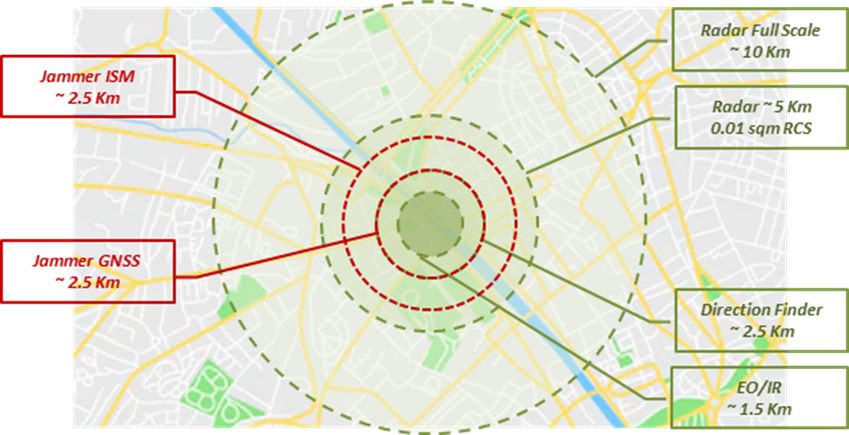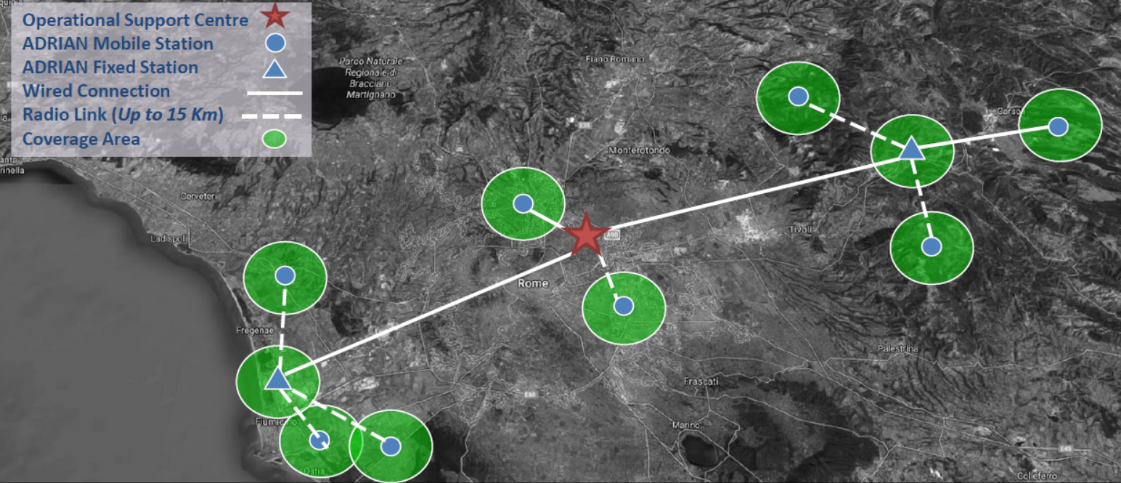Counter-drone Area Protection
Counter-UAS are applied both in military field (protection of high value installation) and in civil field (protection of sensitive targets against terrorism).
Installation in military mission theatre will include the hard-kill effectors to shot down the UAS; more caution must be kept when the UAS is near to civil or sensible targets. In those cases, the shooting down of the UAS may be not suitable and non-kinetic technique must be used.
In addition, if the detection of larger UAS (Class II and Class III) is very similar to the detection of aircraft, the detection of smaller UAS (Class I) is a very different matter since their low radar cross section (RCS) and their flight profile.
Therefore, a Counter UAS System (CUAS) demands detection with multiple sensors operating in different domains, reliable identification capability, real time data fusion, and smart jamming techniques.

Figure 1: Example of Local Area protection Layers
Specific challenges:
• Detection & Tracking: low speed, low altitude, very small RF, thermal and acoustic signatures, high maneuverability.
• Countering: threats are getting resilient to First Generation C-UAS systems that rely on “traditional” detection and neutralization, flying in swarm, possibly boosted by autonomous guidance, using “per-opportunity” data-link and communication means (i.e. 5G). Hard kill not always applicable due to scenario constraints.
• Application: from individual soldier, vehicle and command post to larger critical infrastructures, including urban areas.
• Design: inherent modularity, scalability and interoperability.

Figure 2: Example of Integrated network with common Operational support Center
Main characteristics:
• Open, flexible, modular and scalable architecture based on a plug-and-play component approach that allows deployment of specific configurations adapted to the threat scenarios.
• Detection, recognition, classification, identification and assessment balanced across the adopted sensors and timely reported to the central C2 to reduce operational work force load and bottlenecks.
• Cost-effectiveness and relevance of neutralization solutions to the characteristics of the threat (including swarms) and to the operational environment (hard-kill and soft-kill).
• Command and control: Mission planning, Data fusion, System monitoring, TEWA (Threat Evaluation and Weapon Assignment), Decision support, Result assessment and reporting, Subsystem’s dynamic deployment and integration.
• Security and Interoperability: lowest possible security classification level and interoperability with other C2 systems (e.g. air defense systems) at higher security classification level.
• Deployment: fixed and deployed “pop-up” applications.
System capabilities:
• detect, classify, track, identify and counter UASs (single and/or multi-UAVs) in defense scenarios using multiple technologies; the ability of the proposed solution from detection to counter UASs also in civil scenarios is considered a significant plus;
• Deliver and update real-time operational picture and alerts;
• Integrate into multilayer C2 system with cross-security-domain approach. Two main operational modes can be identified:
• Soft
• Hard (integrating Soft Kill capabilities and supporting functions)
• Provide a range of selective mitigation alternatives with the ability to evaluate mission success probabilities and resulting drawback;
• Require limited logistic support for deployment and maintenance;
• Require minimum operator effort for decision making;
• Provide dynamic scalability of sensors and effectors;
• Facilitate the incorporation of counter UASs in security and defense systems for fixed and deployed asset;
• Operate in a wide range of climate (e.g. arctic, subtropical) and weather (e.g. rain, fog, snow) conditions.
All the active and passive sensors and the effectors are integrated and connected in a local command and control station.
This station implement automatic procedures and rules in order to focus human operations on action, resources coordination and cooperation.








